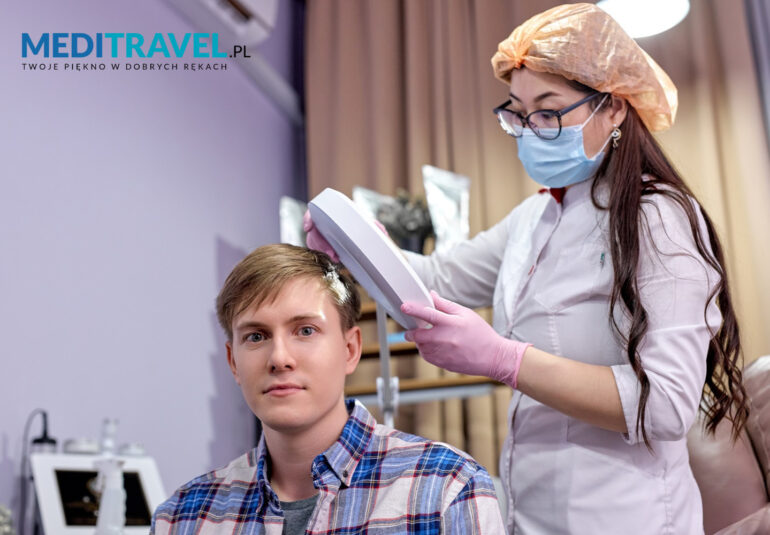
Hair transplantation for women – is it possible?
Hair transplantation is mainly discussed in the context of men. Men benefit from this treatment very often. This is due to the fact that men most often suffer from excessive hair loss and, as a result, baldness. However, this does not mean that this problem does not concern women. It is estimated that about 1/4 of all baldness cases affect women. This can be quite troublesome, as full hair is perceived as an attribute of femininity and a symbol of attractiveness. No wonder that this condition causes complexes and low self-esteem in women. Aesthetic medical treatments can help women struggling with baldness. Let’s find out in this article, if a hair transplantation for women is possible.
Causes of female hair loss
There is no shortage of reasons for hair loss in women. However, it is estimated that 20-60% of women suffer from androgenetic alopecia. This ailment is most often diagnosed in women below 60 years of age. Androgenetic alopecia is associated with excessive androgen secretion. Symptoms of this are hairline recession on the temples (hairline bends) and baldness on top. In women, androgenetic alopecia is often also manifested by diffuse thinning of the hair on top of the head. The cause of androgenetic alopecia is usually genetic.
In women, hair loss may also be caused by diseases such as hyperthyroidism, polycystic ovarian syndrome or genital tumours. Some contraceptive pills, especially those containing synthetic progesterone preparations, may also contribute to hair loss.
Other causes of baldness in women include:
- genetic conditions
- precocious puberty
- ovarian tumours after removal of the uterus
- alopecia areata, post-traumatic alopecia, alopecia after irradiation, after burns
- alopecia caused by inflammatory conditions of the scalp
- post-operative hairless scars on the scalp
- hair loss due to invasive hairdressing procedures, excessive pulling with an elastic band, twisting, styling etc.
- severe stress
- Mycosis infection
A hair transplant may be the solution to this type of problem.
Symptoms of female hair loss
Hair loss in women gives slightly different symptoms than that occurring in men. The most common female hair problems that can be neutralised by a suitable transplant are:
- thinning of hair at the temples, frontal region or on the crown of the head
- general thinning of the hair
- too high forehead margin line
- hair loss after injuries
- hair loss due to invasive hairdressing procedures, excessive pulling with an elastic band, twisting, styling, etc.
If you notice these symptoms in yourself, it is worth seeking professional help. The symptoms mentioned above should not be underestimated as the lack of treatment will result in complete hair loss. It should be noted here that many women come to the doctor for transplantation very late, so that the treatment has to be more invasive.
When can a female hair transplant be carried out?
Hair transplantation is currently the most effective method of combating baldness in both men and women. The indication for this procedure in the fair sex is:
- baldness, whatever its type
- high forehead – a transplant will allow you to lower the hairline and wear any hairstyle
- intensive hairdressing and styling procedures which have caused excessive hair loss
- chemotherapy and radiotherapy,
- hair loss caused by menopause and lowered estrogen levels,
- disappointment with the ineffectiveness of drug treatment and dietary supplementation.
What does a hair transplant for women look like?
Before a woman undergoes a hair transplant, proper preparation of the patient is necessary. This begins with a medical consultation. In Meditravel it can be done online by sending an e-mail with photos of the head. On their basis the surgeon will assess whether a hair transplantation is possible, will recommend the method of transplantation, as well as the number of grafts needed to achieve an optimal effect. Alcohol, coffee, caffeine-containing drinks, medicines, dietary supplements affecting blood clotting, e.g. aspirin, anti-inflammatory medicines, ginger, ginseng, as well as medicines, dietary supplements and cosmetics for hair loss should be omitted 2 weeks before the procedure.
Hair transplantation in women can be performed by one of two methods: FUE or DHI. Both work similarly and offer high efficacy and very good results. The transplantation procedure involves the transplantation of individual hair follicles, usually taken from the back of the head. The follicles, once taken, are prepared for transplantation and then implanted in the areas affected by alopecia.
The entire procedure is performed under local anaesthetic and takes between 3 and 6 hours. The transplant takes place in one session. The transplantation does not need to be repeated. Local anaesthesia makes female hair transplantation safe and virtually painless.
Which clinics perform hair transplants for women?
Most plastic surgery clinics specialise in hair transplantation in men. However, this type of transplantation performed on women is much less popular. If you want to put yourself in the hands of specialists, it is worth betting on clinics with experience in transplantation in both genders. Such is Clinacana Clinic from Turkey, with which Meditravel cooperates. The clinic can boast of international accreditations and world-renowned doctors.
Hair transplants for women are supervised by Professor Dr Soner Tadlidede, who, among other things, worked at Harvard in the USA. However, Turkish plastic surgery clinics are famous not only for their professional, experienced staff, but also for their high-quality equipment and the use of the latest hair transplantation methods.
How much does a hair transplant for women cost?
The price of a hair transplant for women does not differ from that of a male hair transplant. Most central European clinics offer the operation at the price of about 2-3 € per graft. Meditravel clients can count on much better prices. It results from the fact that hair transplantation in Turkey is even up to 70% cheaper than in most European countries. Here you can check the current offers.
It includes VIP transfer within Turkey, 3-day stay in a luxury hotel with SPA and breakfasts for the patient and her companion, hair transplantation up to 5000 grafts, necessary examinations and medicines after the procedure, online consultation and a certificate guaranteeing the quality of the operation. It is also possible to order a package which includes the flight tickets. Such a hair transplant for women is additionally affordable.
What are the results of female hair transplantation?
Hair transplantation for women will allow:
- hide the curve,
- eliminate baldness on top of the head,
- lower the forehead line (get rid of the so-called high forehead),
- thicken hair.
Hair starts to grow as early as 14 days after the procedure, however it may fall out. Permanent hair starts to grow after 3 months, for the full effect of hair transplantation you need to wait about 12 months. Transplanted hair looks natural and does not create the effect of a wig or cosmetics. Importantly, transplanted hair does not fall out, can be styled normally, curled, straightened, coloured, trimmed, washed and cared for.
Recovery after female hair transplant
Hair transplantation in women is not an invasive or painful procedure. This means that many months of difficult convalescence after transplantation are not necessary. After the procedure, the donor area (place of grafts’ intake) is protected with a bandage, which can be removed the next day. At the clinic, each patient is given a loose head covering, which must be worn to protect the head from the sun and negative weather conditions. This makes hair transplantation in women a procedure with a very low risk of possible complications.
During the period of convalescence it is also necessary to make sure to wear a special pillow on the neck to sleep, which stabilises the position of the head during sleep and minimises damage to the recipient area. After the procedure, you must strictly follow the instructions on how to wash your head and only use cosmetics received at the clinic. It takes approximately 14 days for the scalp to fully heal. During this time you should avoid physical exercise, sports, and for the next 6 months solarium and sunbathing. Precise postoperative instructions are given to the patient at the clinic where the hair transplantation is performed.



